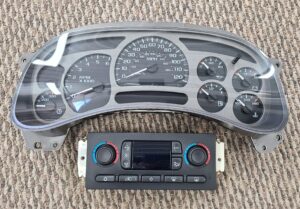Discover Top Techniques for Reliable Auto Instrument Cluster Repair Service and Maintenance
In the realm of auto maintenance, the elaborate system of an instrument cluster plays a crucial function in giving vehicle drivers with necessary details regarding their car's efficiency. Stay tuned to uncover the top methods that can enhance the process of auto instrument collection repair service and maintenance, ultimately improving your driving experience and car efficiency.
Typical Instrument Collection Issues
Some typical problems may occur with automobile tool collections, influencing their capability and precision. One widespread issue is a malfunctioning speedometer, which can lead to security issues and possible legal issues otherwise addressed promptly. This concern frequently stems from a defective rate sensor or damaged electrical wiring, causing inaccurate rate readings or full failing of the speedometer. An additional regular problem is a non-responsive gas scale, leading to unpredictability regarding fuel levels and prospective unanticipated breakdowns. This problem can be triggered by a defective fuel degree sensing unit or a malfunctioning gauge collection. In addition, flickering or dim control panel lights prevail grievances amongst lorry owners. This issue may be credited to loose links, a falling short dimmer switch, or worn-out bulbs. These troubles can hinder the chauffeur's capability to check crucial lorry information, stressing the importance of prompt tool collection repair work and upkeep to ensure optimal functionality and accuracy while driving.
Crucial Tools for Repair Work
When addressing typical tool cluster problems such as malfunctioning speedometers, less competent fuel evaluates, or dark dashboard lights, having the crucial tools for fixing is critical in ensuring reliable and exact diagnostics and upkeep. Among the primary tools required for car instrument collection repair are a digital multimeter for testing voltage and resistance levels, a welding torch for fixing loosened connections or damaged elements, and a set of screwdrivers for dismantling the collection. Furthermore, specialized tools like collection removal hooks might be necessary for safely separating the cluster from the dashboard.

Diagnostic Strategies for Troubleshooting
Using sophisticated diagnostic methods is crucial in efficiently troubleshooting issues within automobile tool clusters to pinpoint and address hidden problems precisely. When confronted with a malfunctioning instrument cluster, specialists typically depend on analysis devices like multimeters, scan tools, and specialized software to recognize the root cause of the trouble. These devices enable specialists to pop over to this web-site access the cluster's inner systems, fetch mistake codes, and perform system examinations to diagnose problems effectively. In addition, techniques such as circuit screening, voltage checks, and signal analysis play an important role in identifying complex electronic mistakes original site within the tool collection. By complying with methodical analysis treatments and translating diagnostic outcomes properly, professionals can improve the troubleshooting process and guarantee the correct functioning of the instrument collection. Regular training and staying upgraded on the current diagnostic innovations are essential for specialists to effectively troubleshoot contemporary instrument collections with advanced functions. An extensive analysis technique not only saves time yet additionally advertises precision in identifying and solving instrument collection issues quickly.
Cleansing and Upkeep Tips

Software Application Updates and Calibration

Calibration is an additional crucial facet of keeping your car tool collection. This procedure involves adjusting the setups and specifications within the software application to ensure that the presented information, such as speed, fuel degree, and temperature level, is exact and reputable. Appropriate calibration not only improves the user experience yet additionally adds to safety and security on the roadway by giving drivers with accurate and reliable data.
To guarantee that your vehicle tool cluster operates ideally, it is suggested to adhere to the maker's YOURURL.com standards concerning software program updates and calibration intervals. By staying aggressive in these areas, you can maximize the efficiency and life expectancy of your instrument cluster.
Conclusion
Finally, efficient vehicle instrument cluster repair and upkeep need a complete understanding of common problems, important tools, diagnostic strategies, cleansing techniques, and software updates. By making use of these methods, service technicians can effectively fix and fix tool cluster problems, making sure reputable and precise efficiency of the vehicle's control panel screen. Normal upkeep and calibration are crucial to avoiding future concerns and guaranteeing the correct performance of the tool collection.
When resolving usual tool collection concerns such as malfunctioning speedometers, unresponsive gas evaluates, or dark control panel lights, having the vital devices for repair is critical in making sure precise and effective diagnostics and upkeep. Amongst the primary tools required for car tool cluster repair service are an electronic multimeter for testing voltage and resistance degrees, a soldering iron for repairing loose links or malfunctioning parts, and a set of screwdrivers for taking apart the cluster. Furthermore, specialized devices like cluster elimination hooks might be necessary for securely removing the cluster from the dashboard.
In verdict, effective auto instrument collection repair work and upkeep call for a detailed understanding of common problems, necessary devices, diagnostic methods, cleansing techniques, and software program updates. Normal maintenance and calibration are vital to stopping future issues and making sure the proper performance of the instrument collection.